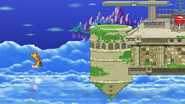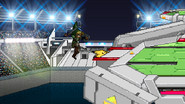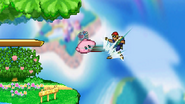mNo edit summary |
m (→Different edgeguards and their guard breaks: grammar stuff) Tag: Visual edit |
||
| Line 4: | Line 4: | ||
== Different edgeguards and their guard breaks == |
== Different edgeguards and their guard breaks == |
||
| − | *'''Interruption guard''': These guards involve the edgeguarder jumping slightly or completely off the stage to |
+ | *'''Interruption guard''': These guards involve the edgeguarder jumping slightly or completely off the stage to attack a recovering opponent. This puts the opponent in a very tricky situation, forcing them to mix up their recovery options to guard break it. However, in cases where a character's recovery is linear, predictable, and unsafe, such as {{SSF2|Ness}}, they usually cannot deal with this type of pressure, making it extremely efficient against these types of characters. |
**'''Spike guard''': This guard is used by characters with a strong [[meteor smash]], usually an aerial one (thus making it a sub-type of the interruption guard). The guarder attempts to hit with a meteor smash to KO opponents. It is a very successful type of guard as the guarded must air dodge, or he or she will be [[KO]]'ed. |
**'''Spike guard''': This guard is used by characters with a strong [[meteor smash]], usually an aerial one (thus making it a sub-type of the interruption guard). The guarder attempts to hit with a meteor smash to KO opponents. It is a very successful type of guard as the guarded must air dodge, or he or she will be [[KO]]'ed. |
||
| − | *'''Projectile guard''': These guards involve |
+ | *'''Projectile guard''': These guards involve using a projectile to push an opponent offstage. This type of guard is easily broken by recovering low, but can be lethal against a character who has a below-average vertical recovery, such as Ichigo. For these characters, air dodging at the right time is vital, or they will get KO'd. |
*'''Reflect guard''': This guard is used by characters who have a special move that can change the direction of a projectile/character. When someone tries to recover, this is used to change the opponent's direction away from the stage, forcing them to fall to their death. The best example of this guard is {{SSF2|Mario}} and his [[Cape]]. |
*'''Reflect guard''': This guard is used by characters who have a special move that can change the direction of a projectile/character. When someone tries to recover, this is used to change the opponent's direction away from the stage, forcing them to fall to their death. The best example of this guard is {{SSF2|Mario}} and his [[Cape]]. |
||
Revision as of 21:41, 25 March 2020

|
It has been suggested that this article be the merge recipient.
The editor who added this tag believes this article should have the content of the following merged with it: |

|
This article may require some new images.
Whether it is a new image or simply a higher quality update, upload the new file and add it into the article. Remember to always upload an updated file under the same name as the older version to supersede it. |
Edgeguarding (also called edge-guarding) is the act of attempting to stop the opponent from successfully recovering. The opposite of edge-guarding is guard breaking.
Different edgeguards and their guard breaks
- Interruption guard: These guards involve the edgeguarder jumping slightly or completely off the stage to attack a recovering opponent. This puts the opponent in a very tricky situation, forcing them to mix up their recovery options to guard break it. However, in cases where a character's recovery is linear, predictable, and unsafe, such as Ness, they usually cannot deal with this type of pressure, making it extremely efficient against these types of characters.
- Spike guard: This guard is used by characters with a strong meteor smash, usually an aerial one (thus making it a sub-type of the interruption guard). The guarder attempts to hit with a meteor smash to KO opponents. It is a very successful type of guard as the guarded must air dodge, or he or she will be KO'ed.
- Projectile guard: These guards involve using a projectile to push an opponent offstage. This type of guard is easily broken by recovering low, but can be lethal against a character who has a below-average vertical recovery, such as Ichigo. For these characters, air dodging at the right time is vital, or they will get KO'd.
- Reflect guard: This guard is used by characters who have a special move that can change the direction of a projectile/character. When someone tries to recover, this is used to change the opponent's direction away from the stage, forcing them to fall to their death. The best example of this guard is Mario and his Cape.
Edgehogging
Another way players can edgeguard their opponents is to prevent their opponents from grabbing the edge by "hogging" the edge themselves. This is usually done after the player who is trying to recover has performed his/her recovery move and is attempting to grab the ledge. The guarded is generally in serious trouble. The only possible guard break is to either land onstage or attack the edgehogger after the invincibility frames have ceased.
Fence/Wall of pain
This is a guard in which the edgeguarder repeatedly attacks the guarded with a repeated amount of forward or back aerial attacks to knock him or her towards the blast line for a KO. It is best performed with Jigglypuff, since her aerials do not give enemies the time to react out of them, but a "Fence of Pain" can be performed by Kirby, Tails, and Meta Knight. Kirby's Fence of Pain can be done with his back aerial, Tails's can be done with his forward aerial, and Meta Knight's can be done with his neutral aerial.





